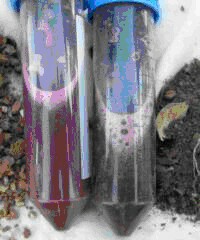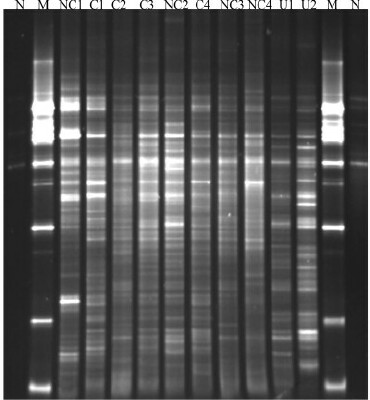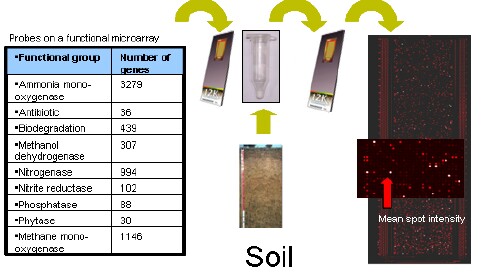Soil Biological Tests
Why is Soil Biology Important? | What Regulates Soil Biology? | Measuring Soil Biology | Management and Soil Biology | Soil Evaluation of Biological Productivity
Name of test | |
| Simple description of method and purpose | A simple method whereby earthworm numbers and species types are counted from paddock sample sites are varying depths. Not useful in areas where rainfall is below 600 mm as very little variation in count numbers is observed between samples. Also, seasonality is a factor as earthworms tend to be dormant (deep underground) in hot dry months. Therefore best to sample in wetter periods. Is considered a general indicator of soil health, particularly soil structure and carbon levels. |
| Complexity rating | A very simple on-site test that can be carried out by anyone. |
| Technology rating | No specialist equipment needed. Some reference to identify species types required. |
| Cost ($$ and time) | Inexpensive and quick |
| Interpretation | No clear benchmarks - however, numbers respond to changes in moisture levels and pH. |
| Decision | Would not use for in paddock decisions |
Name of test | |
| Simple description of method and purpose | A cotton strip is inserted into a soil sample/ area and left for a period of time after which the fibre tensile strength of the cotton strip is measured on a tensiometer or any instrument that can measure tensile strength. This test gives a general indication of the decomposer potential of the soil. |
| Complexity rating | A simple method |
| Technology rating | No complex equipment required apart from a tensiometer, however samples could be sent off for such analysis. |
| Cost ($$ and time) | Inexpensive. Time required for decomposer activity to occur. |
| Interpretation | No clear benchmarks |
| Decision | Would not use for in paddock decisions |
Name of test | |
| Simple description of method and purpose | Some management practices can change the relative abundance of fungi and bacteria in the soil so this ratio can be used as an indicator to assess the effects of management strategies. There are several ways to measure this - 1) direct count method - Fungi and bacteria can be directly assessed by plate counts and the ratio of their abundance calculated; 2) Phospholipid fatty acid analysis (PLFA) -this method uses biochemical tests of fungi and bacteria (fatty acid analysis) as a basis for estimating the proportion of fungi and bacteria in soil; 3) substrate induced respiration (SIR) - this method assesses the ratio of fungi and bacteria in soil based on response to addition of carbon substrates. It is based on inhibition of fungi and bacteria in separate assays and inhibition of all biological activity as a control which is difficult to achieve across different soils. Gives a general indication of soil health. |
| Complexity | Plate count method is straightforward - any technician could carry it out. PLFA and SIR are more complex - some specialist knowledge required. |
| Technology | Plate count method requires some specialist equipment/facilities while PLFA and SIR require specialist equipment. |
| Cost ($$ and time) | These techniques are moderately expensive and require some time to carry out. |
| Interpretation | No benchmarks and data quite difficult to interpret - many would question validity of this measure. |
| Decision | Would not use for in paddock decisions |
Name of test | |
| Simple description of method and purpose | Microbial biomass measures give an indication of the total potential weight of microorganisms in soil. This methodology gives an estimation of the amount of carbon, nitrogen, phosphorus and sulfur in living soil organic matter. Microbial biomass in soil can be measured by fumigation- incubation, fumigation-extraction and substrate-induced respiration methods. Fumigation methods involve killing the microbial biomass then extracting released nutrients such as nitrogen. Methodological problems associated with applying these methods to different soil types and at different times of the year have been extensively researched and the practical aspects are well understood. The identity of individuals making up the microbial biomass is not determined by these methods and this may be seen as a potential limitation. |
| Complexity | Method is straightforward - some specialist knowledge required. |
| Technology | Requires some specialist equipment/facilities. |
| Cost ($$ and time) | Relatively inexpensive but very time consuming and laborious. |
| Interpretation | No benchmarks widely accepted, however generally microbial biomass carbon (MBC) between 1 to 5 % of total organic carbon is normal in eastern Australian soils. Consideration should be given to problems associated with applying different methods to different soil types and at different times of the year. |
| Decision | Can be used (with careful interpretation and advice) to help make in paddock decisions regarding management practices. |
Name of test | |
| Simple description of method and purpose | This measure can give an indication of the activity of soil organisms. This may be more relevant than the abundance of organisms for some purposes, however, it is beneficial to measure both abundance and activity of soil organisms. The most common methods measure basal carbon dioxide respiration (carbon released as microorganism utilise carbon as an energy source from soil organic matter) either insitu (e.g Dreager tube apparatus) or off site in sealed containers. Carbon dioxide measures can be obtained directly with a gas analyser or indirectly by titration. This method is a potential indicator of the biological state of soil. However there is no indication of which organisms are responsible for the activity and there may be issues relating to microbial stress response affecting results. |
| Complexity | Methods are very straightforward - any technician could carry them out. |
| Technology rating | Requires only some specialist equipment/facilities for direct measure of carbon dioxide. |
| Cost ($$ and time) | Relatively inexpensive however time consuming and laborious for multiple samples. |
| Interpretation | No benchmarks widely accepted. |
| Decision | Can be used (with careful interpretation and advice) to help make in paddock decisions regarding management practices. |
Name of test | |
| Simple description of method and purpose | Potentially mineralisable nitrogen (PMN) is an indicator of the capacity of the soil microbial community to convert (mineralise) nitrogen tied up in complex organic residues into the plant available form of ammonium. Soil samples are incubated for 7 days and the amount of ammonium produced in that period reflects the capacity for nitrogen mineralisation. The PMN test provides an indication of the capacity of the soil (the soil microbes) to recycle organic nitrogen into the plant available forms. Soils with high levels of nitrogen-rich organic matter (e.g., soils where legumes are in rotation) tend to have the highest populations of microbes involved in nitrogen mineralisation and the highest PMN rates. |
| Complexity rating | Method is straightforward - some specialist knowledge required. |
| Technology rating | Requires some specialist equipment/facilities. |
| Cost ($$ and time) | Relatively inexpensive and quick. |
| Interpretation | No benchmarks widely accepted. |
| Decision | Can be used (with careful interpretation and advice) to help make in paddock decisions regarding management practices. |
Name of test | |
| Simple description of method and purpose | Specific microbial enzyme activities can be measured to give an indication of specific microbial processes carried out in the soil. Various biochemical assays exist for a range of enzymes including cellulase, ligninase, etc. Such assays can be used as general indicators of soil microbial health or more likely may be used to address more specific questions about microbial processes. |
| Complexity | Methods are generally straightforward - any technician could carry them out - some specialist knowledge required. |
| Technology rating | Requires some specialist equipment/facilities. |
| Cost ($$ and time) | Relatively inexpensive and generally quick. |
| Interpretation | No general benchmarks widely accepted for soil health, however, more likely to be used to answer specific questions. |
| Decision | Not useful for general in paddock management decisions but could help address specific questions. |
Name of test |  | |
| Simple description of method and purpose | Active carbon is an indicator of the fraction of soil organic matter that is readily available as a carbon and energy source for the soil microbial community (i.e., food for the soil food web). The soil is mixed with potassium permanganate (deep purple in colour) and as it oxidises the active carbon the colour changes (becomes less purple), which can be observed visually, but is very accurately measured with a spectrophotometer. Active carbon is positively correlated with percent organic matter, aggregate stability, and with measures of biological activity such as soil respiration rate. Research has shown that active carbon is a good “leading indicator” of soil health response to changes in crop and soil management, usually responding to management much sooner (often, years sooner) than total organic matter percent. Thus, monitoring the changes in active carbon can be particularly useful to farmers who are changing practices to try to build up soil organic matter (e.g., reducing tillage, using new cover crops, adding new composts or manures). | |
| Complexity | Method is straightforward - little specialist knowledge required. | |
| Technology rating | Requires no specialist equipment/facilities other than access to a spectrophotometer for more complex version of the test. | |
| Cost ($ and time) | Inexpensive and quick - simple comparison can be carried out in the paddock. | |
| Interpretation | No benchmarks widely accepted, however useful for comparison between management treatments. | |
| Decision | Useful for in paddock decision making regarding management practices influencing organic carbon content. |
Name of test | |
| Simple description of method and purpose | The Biolog Plate test represents a sensitive and rapid method for assessing the potential metabolic diversity of microbial soil communities. Furthermore, the ecological relevance of certain contaminants such as herbicides, pesticides and metals to soil bacterial communities can also be assessed. The test involves inoculating samples into microplates that contain different carbon sources in addition to a tetrazolium dye. The utilisation of any carbon source by the microbial community results in the respiration-dependent reduction of the dye and purple colour formation that can be quantified and monitored over time. |
| Complexity rating | Method is straightforward - some specialist knowledge required. |
| Technology rating | Requires no specialist equipment/facilities other than access to the Biolog plates. |
| Cost ($$ and time) | Relatively inexpensive and quick - simple comparison can be carried out in the paddock. |
| Interpretation | No benchmarks widely accepted. |
| Decision | Not overly useful for in paddock decision making. |
Name of test | |
| Simple description of method and purpose | Measurement of length of fungal hyphae (or scoring root colonisation) is possible but it is not usually possible to identify the fungi present. Soil microorganisms can be isolated from the soil environment and grown on artificial media. Different media encourage the growth of different types of microorganisms through the use of inhibitors and specialised growth substrates. The numbers of organisms capable of growth on a specific media are referred to as "colony forming units" (CFU) but this represents only 1-5% of the total population so has obvious limitations. Rhizobia (N fixing bacteria) can also be isolated and identification is possible from nodules on field plants. |
| Complexity rating | Method is straightforward - some specialist knowledge required for identification. |
| Technology rating | Requires some moderately specialist equipment/facilities for isolation/culturing. |
| Cost ($$ and time) | Relatively inexpensive and reasonably quick - allow time for culture growth. |
| Interpretation | No benchmarks widely accepted - massive underestimations from culture data regarding taxonomic and functional diversity. |
| Decision | Some use for in paddock decision making. |
Name of test | |
| Simple description of method and purpose | Individual specific taxonomic or functional groups of soil microorganisms can be targeted by direct DNA extraction from soil. Molecular techniques (e.g. real-time polymerase chain reaction (qPCR)) can be used note presence/absence or quantify the number of organisms present giving very useful information depending on what questions are being asked. A good example of this method is the 'Predicta B' test (SARDI) that can be used to target and quantify groups such as plant pathogens (e.g. Rhizoctonia). Can give a very acuate measure of potential population sizes within the soil or potential activities relating to soil processes if a functional gene is targeted. |
| Complexity rating | Complex techniques - specialist knowledge required to carry out molecular techniques. |
| Technology rating | Requires specialist equipment/facilities. |
| Cost ($$ and time) | Moderate expense and reasonably quick. |
| Interpretation | No benchmarks in place to relate specific numbers to soil health - however very good for paddock to paddock or within paddock comparisons and can be used to give a regional perspective - also useful for trials. |
| Decision | Useful for in paddock decision making such as nitrogen fixing and mycorrhizal amendments or tests for pathogens and pests. |
Name of test | |
| Simple description of method and purpose | Taxonomic or functional groups of soil microorganisms can be targeted by direct DNA extraction from soil. Molecular techniques such as denaturing gradient gel electrophoresis (DGGE) or terminal restriction fragment length polymorphism (TRFLP) analysis can be used to generate a community profile or “fingerprint” for an entire specific microbial population or community in the soil. Useful to compare soil microbes at the semi-quantitative community level in response to management practices. |
| Complexity rating | Complex techniques - specialist knowledge required to carry out molecular techniques. Knowledge of statistical tools essential. |
| Technology rating | Requires specialist equipment/facilities. |
| Cost ($$ and time) | Moderate expense and reasonably quick - some time spent on data analysis. |
| Interpretation | No benchmarks in place to relate community changes to soil health - however, very good for paddock to paddock or within paddock comparisons and can be used to give a regional perspective - also useful for trials. |
| Decision | Useful for in paddock decision making but probably still a little too expensive for general use as a soil health indicator. Will become cheaper sooner rather than later. |

The figure shows a DGGE gel with each lane representing a different soil sample.
Within each lane the bands represent putative bacterial species from the soil sample
hence producing a "community fingerprint" from that soil.
Name of test | |
| Simple description of method and purpose | Using microarrays the entire suite of taxonomic and/or functional variation within microorganism communities from soil can be targeted. Useful for determining differential gene expression and as such can be used to determine if particular genes (representing taxonomic groups or functional processes) are up or down regulated between management practices, soil types, climatic regions etc. |
| Complexity | Very complex techniques - specialist knowledge required. |
| Technology rating | Requires specialist equipment/facilities and computer software for data analysis. |
| Cost ($$ and time) | Expensive but reasonably quick. Data analysis is time consuming. |
| Interpretation | No benchmarks in place to relate differential gene expression to soil health - however, very good for paddock to paddock or within paddock comparisons and can be used to give a regional perspective. |
| Decision | Useful for in paddock decision making but a research tool at this stage. At this point too expensive for use as soil health indicator. Will become cheaper with time. |



